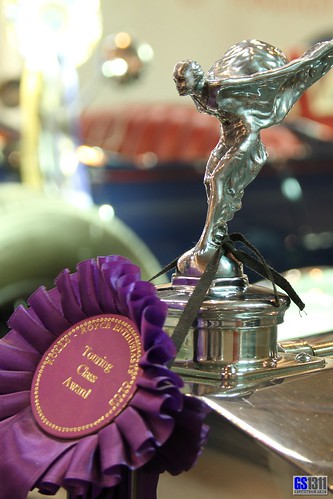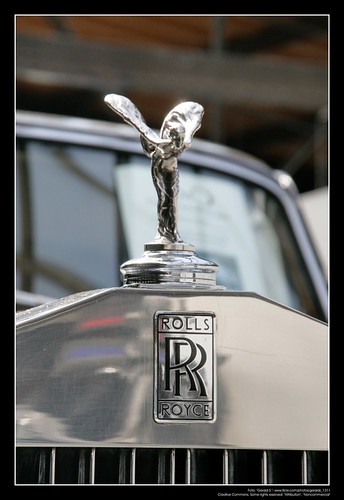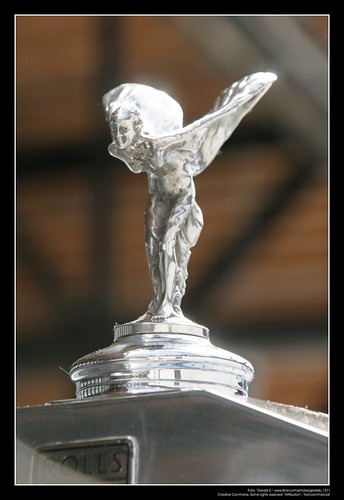1933 Rolls-Royce Phantom II Barker Sporting Saloon
Image by Georg Schwalbach (GS1311)
The Spirit of Ecstasy is the name of the hood ornament on Rolls-Royce cars. It is in the form of a woman leaning forwards with her arms outstretched behind and above her. Billowing cloth runs from her arms to her back, resembling wings.
The Spirit of Ecstasy, also called "Emily", "Silver Lady" or "Flying Lady", was designed by Charles Robinson Sykes and carries with it a story about a secret passion between John Walter Edward Scott-Montagu, (second Lord Montagu of Beaulieu after 1905, a pioneer of the automobile movement, and editor of The Car magazine from 1902) and his secret love and the model for the emblem, Eleanor Velasco Thornton. Eleanor was John Walter's secretary, and their love was to remain hidden, limited to their circle of friends, for more than a decade. The reason for the secrecy was Eleanor's impoverished social and economic status, which was an obstacle to their love. John-Walter, succumbing to family pressures, married Lady Cecil Victoria Constance, but the secret love affair continued.
Eleanor died on 30 December 1915, going down with the SS Persia, when the ship was torpedoed off Crete by a German submarine, whilst she accompanied Lord Montagu on his journey to India, four years after she had been immortalized by her bereaved lover.
(Wikipedia)
- - -
Spirit of Ecstasy ist der Name der geflügelten Kühlerfigur, die seit 1911 den Grill eines Rolls-Royce ziert. Am 6. Februar 1911 wurde die erste Ausführung auf einen Rolls-Royce montiert, es war auch die erste aus Metall gegossene Figur, die in England serienmäßig einer Automarke mitgegeben wurde. Geistiges Vorbild mag eine Statue der Göttin Nike von Samothrake gewesen sein. Modell für die erste Figur stand dem Bildhauer Charles Robert Sykes jedoch die Sekretärin und Geliebte des britischen Adligen John Walter Edward Douglas-Scott-Montagu, 2nd Baron Montagu of Beaulieu, Miss Eleanor Velasco Thornton. Irrtümlicherweise wird die Rolls-Royce-Kühlerfigur heute oftmals „Emily“ genannt.
Lord Montagu ließ sich seinerzeit für seinen privaten Rolls-Royce eine Kühlerfigur gestalten – von eben jenem Bildhauer Charles Sykes – die der Künstler „The Whisper“ (Das Flüstern) nannte. Die Idee des Lords wurde populär und setzt sich durch.
Lord Montagu vermittelte daraufhin Sykes den Auftrag von Rolls-Royce, eine Kühlerfigur zu gestalten. Das Ergebnis ähnelte „The Whisper“ sehr, was nicht besonders erstaunt, da wiederum Eleanor Thornton Modell stand. Miss Thornton starb am 30. Dezember 1915 bei der Versenkung des britischen Passagierdampfers Persia im Mittelmeer. Lord Montagu überlebte.
Ursprünglich sollte die Figur „Spirit of Speed“ heißen, aber dieser Name erschien Rolls-Royce als unenglische Prahlerei. Daher nannte man die Kühlerfigur „Spirit of Ecstasy“.
(Wikipedia)
1964 Rolls-Royce Silver Cloud III (05)
Image by Georg Schwalbach (GS1311)
The Spirit of Ecstasy is the name of the hood ornament on Rolls-Royce cars. It is in the form of a woman leaning forwards with her arms outstretched behind and above her. Billowing cloth runs from her arms to her back, resembling wings.
The Spirit of Ecstasy, also called "Emily", "Silver Lady" or "Flying Lady", was designed by Charles Robinson Sykes and carries with it a story about a secret passion between John Walter Edward Scott-Montagu, (second Lord Montagu of Beaulieu after 1905, a pioneer of the automobile movement, and editor of The Car magazine from 1902) and his secret love and the model for the emblem, Eleanor Velasco Thornton. Eleanor was John Walter's secretary, and their love was to remain hidden, limited to their circle of friends, for more than a decade. The reason for the secrecy was Eleanor's impoverished social and economic status, which was an obstacle to their love. John-Walter, succumbing to family pressures, married Lady Cecil Victoria Constance, but the secret love affair continued.
Eleanor died on 30 December 1915, going down with the SS Persia, when the ship was torpedoed off Crete by a German submarine, whilst she accompanied Lord Montagu on his journey to India, four years after she had been immortalized by her bereaved lover.
(Wikipedia)
- - -
Spirit of Ecstasy ist der Name der geflügelten Kühlerfigur, die seit 1911 den Grill eines Rolls-Royce ziert. Am 6. Februar 1911 wurde die erste Ausführung auf einen Rolls-Royce montiert, es war auch die erste aus Metall gegossene Figur, die in England serienmäßig einer Automarke mitgegeben wurde. Geistiges Vorbild mag eine Statue der Göttin Nike von Samothrake gewesen sein. Modell für die erste Figur stand dem Bildhauer Charles Robert Sykes jedoch die Sekretärin und Geliebte des britischen Adligen John Walter Edward Douglas-Scott-Montagu, 2nd Baron Montagu of Beaulieu, Miss Eleanor Velasco Thornton. Irrtümlicherweise wird die Rolls-Royce-Kühlerfigur heute oftmals „Emily“ genannt.
Lord Montagu ließ sich seinerzeit für seinen privaten Rolls-Royce eine Kühlerfigur gestalten – von eben jenem Bildhauer Charles Sykes – die der Künstler „The Whisper“ (Das Flüstern) nannte. Die Idee des Lords wurde populär und setzt sich durch.
Lord Montagu vermittelte daraufhin Sykes den Auftrag von Rolls-Royce, eine Kühlerfigur zu gestalten. Das Ergebnis ähnelte „The Whisper“ sehr, was nicht besonders erstaunt, da wiederum Eleanor Thornton Modell stand. Miss Thornton starb am 30. Dezember 1915 bei der Versenkung des britischen Passagierdampfers Persia im Mittelmeer. Lord Montagu überlebte.
Ursprünglich sollte die Figur „Spirit of Speed“ heißen, aber dieser Name erschien Rolls-Royce als unenglische Prahlerei. Daher nannte man die Kühlerfigur „Spirit of Ecstasy“.
(Wikipedia)
1964 Rolls-Royce Silver Cloud III (06)
Image by Georg Schwalbach (GS1311)
The Spirit of Ecstasy is the name of the hood ornament on Rolls-Royce cars. It is in the form of a woman leaning forwards with her arms outstretched behind and above her. Billowing cloth runs from her arms to her back, resembling wings.
The Spirit of Ecstasy, also called "Emily", "Silver Lady" or "Flying Lady", was designed by Charles Robinson Sykes and carries with it a story about a secret passion between John Walter Edward Scott-Montagu, (second Lord Montagu of Beaulieu after 1905, a pioneer of the automobile movement, and editor of The Car magazine from 1902) and his secret love and the model for the emblem, Eleanor Velasco Thornton. Eleanor was John Walter's secretary, and their love was to remain hidden, limited to their circle of friends, for more than a decade. The reason for the secrecy was Eleanor's impoverished social and economic status, which was an obstacle to their love. John-Walter, succumbing to family pressures, married Lady Cecil Victoria Constance, but the secret love affair continued.
Eleanor died on 30 December 1915, going down with the SS Persia, when the ship was torpedoed off Crete by a German submarine, whilst she accompanied Lord Montagu on his journey to India, four years after she had been immortalized by her bereaved lover.
(Wikipedia)
- - -
Spirit of Ecstasy ist der Name der geflügelten Kühlerfigur, die seit 1911 den Grill eines Rolls-Royce ziert. Am 6. Februar 1911 wurde die erste Ausführung auf einen Rolls-Royce montiert, es war auch die erste aus Metall gegossene Figur, die in England serienmäßig einer Automarke mitgegeben wurde. Geistiges Vorbild mag eine Statue der Göttin Nike von Samothrake gewesen sein. Modell für die erste Figur stand dem Bildhauer Charles Robert Sykes jedoch die Sekretärin und Geliebte des britischen Adligen John Walter Edward Douglas-Scott-Montagu, 2nd Baron Montagu of Beaulieu, Miss Eleanor Velasco Thornton. Irrtümlicherweise wird die Rolls-Royce-Kühlerfigur heute oftmals „Emily“ genannt.
Lord Montagu ließ sich seinerzeit für seinen privaten Rolls-Royce eine Kühlerfigur gestalten – von eben jenem Bildhauer Charles Sykes – die der Künstler „The Whisper“ (Das Flüstern) nannte. Die Idee des Lords wurde populär und setzt sich durch.
Lord Montagu vermittelte daraufhin Sykes den Auftrag von Rolls-Royce, eine Kühlerfigur zu gestalten. Das Ergebnis ähnelte „The Whisper“ sehr, was nicht besonders erstaunt, da wiederum Eleanor Thornton Modell stand. Miss Thornton starb am 30. Dezember 1915 bei der Versenkung des britischen Passagierdampfers Persia im Mittelmeer. Lord Montagu überlebte.
Ursprünglich sollte die Figur „Spirit of Speed“ heißen, aber dieser Name erschien Rolls-Royce als unenglische Prahlerei. Daher nannte man die Kühlerfigur „Spirit of Ecstasy“.
(Wikipedia)
1925 - 1931 Rolls-Royce Phantom I Roadster (02)
Image by Georg Schwalbach (GS1311)
The Spirit of Ecstasy is the name of the hood ornament on Rolls-Royce cars. It is in the form of a woman leaning forwards with her arms outstretched behind and above her. Billowing cloth runs from her arms to her back, resembling wings.
The Spirit of Ecstasy, also called "Emily", "Silver Lady" or "Flying Lady", was designed by Charles Robinson Sykes and carries with it a story about a secret passion between John Walter Edward Scott-Montagu, (second Lord Montagu of Beaulieu after 1905, a pioneer of the automobile movement, and editor of The Car magazine from 1902) and his secret love and the model for the emblem, Eleanor Velasco Thornton. Eleanor was John Walter's secretary, and their love was to remain hidden, limited to their circle of friends, for more than a decade. The reason for the secrecy was Eleanor's impoverished social and economic status, which was an obstacle to their love. John-Walter, succumbing to family pressures, married Lady Cecil Victoria Constance, but the secret love affair continued.
Eleanor died on 30 December 1915, going down with the SS Persia, when the ship was torpedoed off Crete by a German submarine, whilst she accompanied Lord Montagu on his journey to India, four years after she had been immortalized by her bereaved lover.
(Wikipedia)
- - -
Spirit of Ecstasy ist der Name der geflügelten Kühlerfigur, die seit 1911 den Grill eines Rolls-Royce ziert. Am 6. Februar 1911 wurde die erste Ausführung auf einen Rolls-Royce montiert, es war auch die erste aus Metall gegossene Figur, die in England serienmäßig einer Automarke mitgegeben wurde. Geistiges Vorbild mag eine Statue der Göttin Nike von Samothrake gewesen sein. Modell für die erste Figur stand dem Bildhauer Charles Robert Sykes jedoch die Sekretärin und Geliebte des britischen Adligen John Walter Edward Douglas-Scott-Montagu, 2nd Baron Montagu of Beaulieu, Miss Eleanor Velasco Thornton. Irrtümlicherweise wird die Rolls-Royce-Kühlerfigur heute oftmals „Emily“ genannt.
Lord Montagu ließ sich seinerzeit für seinen privaten Rolls-Royce eine Kühlerfigur gestalten – von eben jenem Bildhauer Charles Sykes – die der Künstler „The Whisper“ (Das Flüstern) nannte. Die Idee des Lords wurde populär und setzt sich durch.
Lord Montagu vermittelte daraufhin Sykes den Auftrag von Rolls-Royce, eine Kühlerfigur zu gestalten. Das Ergebnis ähnelte „The Whisper“ sehr, was nicht besonders erstaunt, da wiederum Eleanor Thornton Modell stand. Miss Thornton starb am 30. Dezember 1915 bei der Versenkung des britischen Passagierdampfers Persia im Mittelmeer. Lord Montagu überlebte.
Ursprünglich sollte die Figur „Spirit of Speed“ heißen, aber dieser Name erschien Rolls-Royce als unenglische Prahlerei. Daher nannte man die Kühlerfigur „Spirit of Ecstasy“.
(Wikipedia)
1929 Rolls-Royce 20/25 HP (01)
Image by Georg Schwalbach (GS1311)
The Rolls-Royce 20/25 built between 1929 and 1936 succeeded the 20 hp as Rolls-Royce's "small car". It was intended to appeal to owner drivers, but many were sold to customers with chauffeurs.
Only the chassis and mechanical parts were made by Rolls-Royce. The body was made and fitted by a coachbuilder selected by the owner. Amongst the most famous coachbuilders who produced bodies for Rolls Royce cars are Park Ward, Thrupp & Maberly, Mulliner and Hooper.
(Wikipedia)
- - -
Der Rolls-Royce 20/25 hp war ein PKW, den Rolls-Royce von 1929 bis 1936 als Nachfolger des 20 hp baute. Der „kleine Rolls-Royce“ war für eigentlich für Kunden gedacht, die sich selbst an Steuer setzen wollten, aber viele Fahrzeuge wurden an Kunden mit Chauffeur verkauft.
Nur Fahrwerk und Mechanik wurden von Rolls-Royce gefertigt. Die Karosserien wurden von Stellmachern nach Wahl des Käufers gebaut und aufgesetzt. Einige der bekanntesten Karosseriebauer für Rolls-Royce-Fahrgestelle waren Park Ward, Thrupp & Maberly, Mulliner und Hooper.
(Wikipedia)





0 comments:
Post a Comment